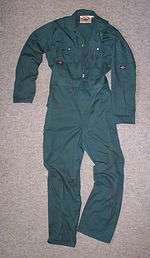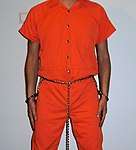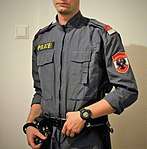Boilersuit
A boilersuit, also known as coveralls, or overalls, is a loose fitting garment covering the whole body except for the head, hands and feet.

Terminology
The term boilersuit is most common in the UK, where the 1989 edition of the Oxford English Dictionary lists the word as having been first used on 28 October 1928 in the Sunday Express newspaper. The garments are typically known as coveralls in North America, while overall(s) is used elsewhere; in North America "overall" is more usually understood as a bib-and-brace overall, which is a type of trousers with attached suspenders.
A more tight-fitting garment that is otherwise similar to a boilersuit is usually called a jumpsuit. The "siren suit" favoured by Winston Churchill (but also worn by many others in the UK when air raids were a threat) during the Second World War was closely similar to a boilersuit.
Description

A boilersuit is a one-piece garment with full-length sleeves and legs like a jumpsuit, but usually less tight-fitting. Its main feature is that it has no gap between jacket and trousers or between lapels, and no loose jacket tails. It often has a long thin pocket down the outside of the right thigh to hold long tools. It usually has a front fastening extending the whole length of the front of the body up to the throat, with no lapels. It may be fastened with buttons, a zip, velcro, or snap fasteners. Boilersuits with an attached hood are available. The word "boilersuit" may also refer to disposable garments such as DuPont's Tyvek suits.
Boilersuits are so called because they were first worn by men maintaining coal-fired boilers. To check for steam leaks or to clean accumulated soot from inside the firebox of a steam locomotive, someone had to climb inside, through the firehole (where the coal is shovelled in). A one-piece suit avoids the potential problem of loosened soot entering the lower half of one's clothing through the gap in the middle. As the firehole opening is only just large enough for a fit individual to negotiate, a one-piece suit also avoids the problem of the waistband snagging on the firehole as one bends to wriggle through, or of jacket tails snagging if one has to come out backwards.
Usage
Coveralls are most often worn as protective clothing over "street" clothes at work, but sometimes instead of ordinary jacket and trousers.

Coveralls are also sometimes used as prison uniforms in the U.S and other countries.

SWAT units often use boilersuits as a uniform, for instance the French police unit Compagnies Républicaines de Sécurité or the Austrian units EKO Cobra and WEGA. Similar coveralls made of Nomex in olive drab (and more recently, desert tan) are also used by the crews of armoured fighting vehicles in the US Army and Marine Corps, where the men and also their suits are sometimes called "CVCs", an abbreviation of "Combat Vehicle Crewman". More form fitting coveralls with many zippered pockets, originally made of cotton treated for flame resistance, but made of Nomex since the late 1960s, have been used as flight suits since the beginning of World War II.
Japanese politicians have been known to use boiler suits to convey an image of preparedness.[1]
Coveralls called student boilersuits are used by university students in some Nordic countries as a sort of party-uniform, with insignia on the back and colour varying with programme and university.
The suit is associated with the slasher subgenre, being worn by Michael Myers of the Halloween films.
Pete Townshend of The Who frequently wore a white boiler suit during performances and in publicity photographs from 1969-71.[2]
The Church of Scientology has punished Sea Org members in the Rehabilitation Project Force by making them wear black boiler suits.[3]
A report in the Daily Telegraph in April 1920 said that "in the last few days" a strong movement, including formation of "overall clubs", had developed in the USA among men who normally wore office suits, to wear overalls instead, in protest against the then-current very excessive price of office-type suits. It started among press agents and theatrical editors. Many newspapers called for this direct action rather than waiting for the United States Department of Justice to prosecute profiteers. This was accompanied by state school schoolboys and schoolgirls passing resolutions to wear khaki (post-WWI widely cheaply available) instead of school uniforms, and editorials advising gingham gowns for women.[4][5][6]
See also
References
- "Archived copy". Archived from the original on 2013-10-01. Retrieved 2013-09-24.CS1 maint: archived copy as title (link)
- "SCIENTOLOGY DENIED: CA Appeals Court Won't Help Church in Forced-Abortion Lawsuit « The Underground Bunker". tonyortega.org. Archived from the original on 2015-01-29.
- Daily Telegraph April 1920, reprinted in Daily Telegraph Saturday 18 April 2020, page 28
- http://ultimatehistoryproject.com/overall-clubs.html
- https://www.victoriaadvocate.com/news/features/100-75-50-and-25-years-ago-1920-the-overall-clubs-were-endorsed-as-protest/article_d5bb0660-7911-11ea-bb05-13104bf7a652.html
| Wikimedia Commons has media related to Boilersuits. |